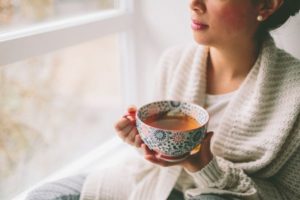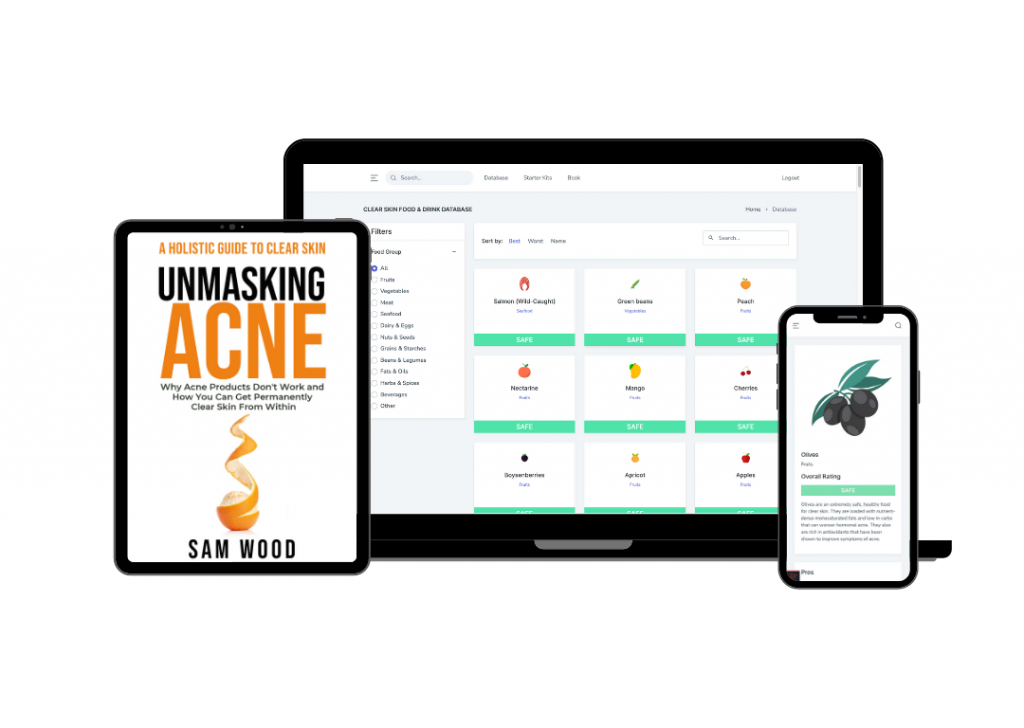Hormonal acne is a complex issue that can be frustrating to deal with and usually requires different approaches before nailing down the cause of the imbalance and finding relief.
And while this condition doesn’t have a one-size-fits-all solution, it’s widely known that diet and lifestyle choices play a significant role in keeping hormones and hormone-caused conditions like acne in check.
Therefore, it’s no surprise that we often find out about a new and exciting component touted as a natural remedy for hormonal acne after doing some digging into the latest research.
One such discovery is chasteberry, a hormone-balancing herb that’s been used for centuries to treat various menstrual and reproductive issues in women.
And since hormonal acne results from fluctuations in hormone levels, it’s not entirely out of the realm of possibility that chasteberry could also help alleviate this condition.
So, if you’re struggling with hormonal acne and are looking for a natural way to find relief, chasteberry may be worth trying.
This herb has a long list of potential benefits, and getting rid of hormonal acne may be one of them, but as with any natural remedy, there are some things to keep in mind before adding it to your routine.
What is Chasteberry?
Chasteberry is a small, dark berry that resembles a peppercorn and grows on the Vitex tree, which is another name for this fruit.
The tree thrives in a warm climate and is native to the Mediterranean and Central Asia, but due to its popularity in herbal medicine, it is now grown in many other parts of the world.
Chasteberry has been used for centuries to treat a variety of medical conditions. However, its most popular use throughout history has been to treat menstrual disorders and fertility problems.
More recently, chasteberry has been shown to help relieve premenstrual syndrome and improve other hormone-related conditions, including skin conditions such as acne.
Types of Chasteberry
There are several different types of chasteberry; however, the two most popular are Vitex Agnus-castus and Vitex negundo.
Vitex Agnus-castus is the most studied for its health benefits and the most commonly used type in supplements, teas, and even skincare products.
On the other hand, we have Vitex negundo, also known as the Chinese chaste tree, which is commonly used in Ayurvedic medicine due to its believed antiarthritic activity.
Additionally, Vitex negundo is also reported to have anti-hyperglycemic and hypouricemic activity, meaning it may help manage diabetes and inflammatory conditions caused by high uric acid levels, such as gout.
But probably the most interesting fact about this particular type of chasteberry is that it’s been shown to have antioxidant and anti-androgenic effects, which could potentially make it beneficial for improving hormone-related conditions like acne.
Chasteberry and Hormones
Chasteberry is most commonly known for its ability to help regulate hormones, thanks to a plethora of active components that have been shown to interact with the endocrine system.
Some of these components include flavonoids, glycosides, and essential oils that impact the adrenal gland, pituitary gland, and hypothalamus, which are all vital to the regulation of hormones.
Additionally, some of the compounds found in chasteberry have been proven to lower estrogen and raise progesterone levels.
A compound known as casticin is thought to be responsible for this estrogen-lowering effect due to its ability to block the follicle-stimulating hormone and raise the luteinizing hormone, which changes the estrogen and progesterone.
But why is this important?
Well, estrogen and progesterone work closely together to maintain a woman’s well-being; therefore, it’s imperative that they stay in balance.
When estrogen levels are too high and progesterone levels are too low, it results in estrogen dominance.
This condition occurs due to the inability of the gut flora to dispose of excess estrogens from food and plastics, oral contraceptives, hormone replacement therapy, and other endocrine disruptors, which leaves women with too much estrogen relative to progesterone.
And this can be a huge issue because it’s proven that most struggles with hormonal imbalances affecting the female brain and body may be associated with estrogen dominance.
This includes everything from fibroids and fibrocystic breasts to heavy and painful periods, hormonal headaches, premenstrual syndrome, and irregular cycles.
Progesterone, on the other side, is a calming hormone, and if you have too little of it, it can result in anxiety, increased stress levels, sleep problems, mood swings, and even inflammatory skin conditions such as acne.
So, by normalizing these hormone levels, chasteberry may help alleviate some of the symptoms associated with estrogen dominance.
Chasteberry & Skin Health
When it comes to skin ailments such as acne, it’s important to understand that this condition is primarily a bacterial problem; however, hormones can also play a role in its development.
We know that before we spot a pimple on the skin’s surface, there’s been a clogged pore that has attracted bacteria to feed on the cellular debris inside it and grow.
This overgrowth has then triggered the immune system to send out inflammatory signals to fight the infection, which has resulted in redness, swelling, and eventually a pimple.
Many things can trigger this process, including an imbalance of good and bad bacteria on the skin, excess sebum production, genetics, diet, and stress.
But one of the most common acne triggers is hormone imbalances, particularly during puberty, pregnancy, and menopause.
Going back to our earlier discussion, we know that estrogen dominance is a hormonal issue that can lead to acne.
This happens because the higher levels of circulating free estrogen in the body can contribute to pro-inflammatory metabolic changes and block the body’s natural elimination pathways, disabling its ability to eliminate excess bacteria.
The bacteria can then be reabsorbed into the bloodstream and end up in the sebaceous glands, where they can trigger an overproduction of what we know as “bad sebum,” a substance that contains an unbalanced ratio of lipids.
This type of sebum is very comedogenic, meaning it’s more likely to clog pores and trigger the formation of pimples.
Now, chasteberry has been shown to have a regulatory effect on hormones, which means that it can help normalize estrogen levels, therefore, reducing the risk of acne formation caused by this particular issue.
In addition, chasteberry is also a promising anti-inflammatory agent and can help soothe the skin and reduce redness and swelling.
However, although there’s no harm in trying this natural remedy, it’s important to remember that chasteberry is not a magic pill, and results may vary from person to person, depending on what might be causing their acne, which, in case you didn’t notice, can be a complex issue.
So, while chasteberry can help relieve inflammation and potentially soothe acne in some cases, it might not be helpful for everyone, so it’s important to keep that in mind before trying it out.
Chasteberry Supplements & Teas vs. Topicals
If you’re considering using chasteberry to improve your hormonal health, there are several forms you can opt for, including supplements, teas, and topical ointments.
Supplements are usually taken in capsules or tinctures and are a convenient way to get a concentrated dose of the herb’s active compounds without overwhelming your system.
Teas, on the other hand, are a gentler way to consume chasteberry and can be a good option if you have an upset stomach or are sensitive to supplements.
Lastly, there are topical ointments that can be applied directly to the skin; however, these are not as commonly used as the other two forms, and there’s no evidence to support any potential benefits for acne.
Regardless of the form you opt for, make sure to buy chasteberry from a reputable source, as the quality of the product can vary greatly.
Chasteberry Risks & Potential Side Effects
Now that we know more about the potential benefits of chasteberry for the skin and body, let’s look at some of the risks and possible side effects associated with its use.
Although extremely rare, chasteberry can cause allergic reactions in some people, and this isn’t something anyone can control or predict as it’s the body’s way of rejecting a substance it disagrees with.
An allergic reaction can be anything from swelling, rashes, and itching to difficulty when breathing, so if you experience any of these symptoms after taking chasteberry, it’s important to discontinue its use and seek medical assistance.
Additionally, some potential side effects of chasteberry can be related to dosing, and if overused, it can sometimes cause issues like stomach problems, nausea, vomiting, and diarrhea.
Finally, because chasteberry can alter your body’s progesterone and estrogen levels, pregnant women or breastfeeding or have hormone-related conditions such as breast cancer should not use chasteberry.
While the risks and side effects of chasteberry are usually mild and rare, it’s always best to use caution when taking any herb or supplement in these circumstances.
Best Ways to Reduce Hormonal Acne
If you’re struggling with hormonal acne and are feeling frustrated and helpless, there are some things that you can do to improve your health and the condition of your skin and reduce breakouts.
One of the best ways to balance your hormones is to focus on maintaining a healthy lifestyle through physical activity, stress-management techniques, and eating a nutritious diet.
This includes consuming plenty of fruits, vegetables, meat, and whole grains while avoiding processed foods, sugary drinks, and inflammation-inducing components found in food.
If you would like to learn more about out how consuming certain foods can help you get clear and healthy skin, you can check out GoodGlow’s Clear Skin Guide. This guide will provide some super useful information on how to balance your hormones and reduce active inflammation on the skin through diet.
In addition, taking care of your skin externally by having a great skincare routine that consists of gently cleansing, exfoliating, and nourishing your skin barrier with the right products can also help you achieve clearer skin.
And while there’s no one-size-fits-all solution for hormonal acne, these lifestyle and skincare tips can help you figure out what works best for your daily routine, your skin type, and your individual needs.

